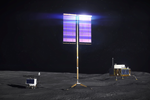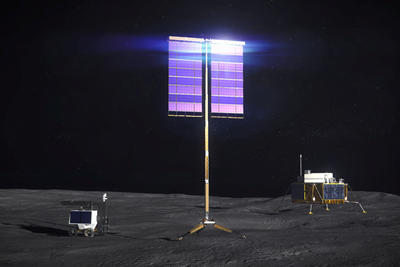NASA’s Artemis I mega rocket launches Orion to moon
The agency’s Orion spacecraft — showcasing an abundance of composite components and structures — launched 1:47 a.m. on Nov. 16, and is on its way to the moon as part of the Artemis program.
NASA’s SLS rocket carrying the Orion spacecraft launches on the Artemis I flight test, Wednesday, Nov. 16 from Launch Complex 39B at NASA’s Kennedy Space Center in Florida. NASA’s Artemis I mission is the first integrated flight test of the agency’s deep space exploration systems: the Orion spacecraft, Space Launch System (SLS) rocket and ground systems. Photo Credit, all images: NASA/Joel Kowsky
Following a successful launch of NASA’s Space Launch System (SLS) rocket, the agency’s Orion spacecraft — showcasing an abundance of composite components and structures — is on its way to the moon as part of the Artemis program. Carrying an uncrewed Orion, SLS lifted off for its flight test debut at 1:47 a.m. EST on Nov. 16 from Launch Pad 39B at NASA’s Kennedy Space Center in Florida.
Orion’s composite features include an Airbus (Bremen, Germany) built European Service Module (ESM), which has a primary structure making high use of carbon fiber composites, Beyond Gravity’s (Zürich, Switzerland) composite large connector (universal stage adapter) that links the launch vehicle and the service module and a composite heat shield design created by Lockheed Martin (Bethesda, Md., U.S.) engineers.
The launch is the first leg of a mission in which Orion is planned to travel approximately 40,000 miles beyond the moon and return to Earth over the course of 25.5 days. Known as , the mission is a critical part of NASA’s moon to Mars exploration approach, in which the agency explores for the benefit of humanity. It’s an important test for the agency before flying astronauts on the mission.
After reaching its initial orbit, Orion deployed its solar arrays and engineers began performing checkouts of the spacecraft’s systems. About 1.5 hours into flight, the rocket’s upper stage engine successfully fired for approximately 18 minutes to give Orion the big push needed to send it out of Earth’s orbit and toward the moon.
Orion has separated from its upper stage and is on its outbound coast to the moon powered by its service module, which is the propulsive powerhouse provided by the European Space Agency (ESA) through an international collaboration.
“It’s taken a lot to get here, but Orion is now on its way to the moon,” Jim Free, NASA deputy associate administrator for the Exploration Systems Development Mission Directorate, says. “This successful launch means NASA and our partners are on a path to explore farther in space than ever before for the benefit of humanity.”
Over the next several hours, a series of 10 small science investigations and technology demonstrations, called , will deploy from a ring that connected the upper stage to the spacecraft. Each CubeSat has its own mission that has the potential to fill gaps in our knowledge of the solar system or demonstrate technologies that may benefit the design of future missions to explore the moon and beyond.
Orion’s service module will also perform the first of a series of burns to keep the launch vehicle on course toward the moon approximately eight hours after launch. In the coming days, mission controllers at NASA’s Johnson Space Center in Houston will conduct and course corrections as needed. Orion is expected to fly by the moon on Nov. 21, performing a close approach of the lunar surface on its way to a distant retrograde orbit, a highly stable orbit thousands of miles beyond the moon.
Engineers previously rolled the SLS rocket back to the Vehicle Assembly Building (VAB) on Sept. 26 ahead of Hurricane Ian and after waving off two previous launch attempts Aug. 29 due to a , and Sept. 4 due to a at an interface between the rocket and mobile launcher. Prior to rolling back to the VAB, teams successfully repaired the leak and demonstrated updated tanking procedures. While in the VAB, teams performed standard maintenance to repair minor damage to the foam and cork on the thermal protection system and recharge or replace batteries throughout the system.
View more photos of Artemis I .
Related Content
Expanding high-temperature composites in India and the U.S.
Azista USA offers polymers and processes for carbon/carbon and other CMC, including novel hot-melt phenolic and phthalonitrile prepregs for faster cycle times, alternative solutions.
Read MoreOptimizing a CFRP landing leg demonstrator
MT Aerospace achieves design for manufacturing, integrating multiple elements into one-piece structure using AFP and 3D printed tooling to meet time and budget constraints.
Read MoreOn the radar: Reusable launch vehicles, hypersonics make space more accessible
CFRP has become key to targeting efforts in reusing components like rocket stages, as well as the development of reusable hypersonic testbeds and spaceplanes, for increasing space commercialization.
Read MoreCall for abstracts: CW Tech Days to explore high-temperature composite solutions
The fall 2025 installment of CW’s Tech Days online event series will cover high-temperature composite solutions for defense and space applications.
Read MoreRead Next
Three companies chosen to advance NASA deployable solar array
Astrobotic Technology, Lockheed Martin and Honeybee Robotics awarded $19.4 million to prototype build and test solar array systems to power moon exploration under Artemis. Current mast designs incorporate carbon fiber-based technologies.
Read MoreCeramic matrix composites: Faster, cheaper, higher temperature
New players proliferate, increasing CMC materials and manufacturing capacity, novel processes and automation to meet demand for higher part volumes and performance.
Read MoreScaling up, optimizing the flax fiber composite camper
Greenlander’s Sherpa RV cab, which is largely constructed from flax fiber/bio-epoxy sandwich panels, nears commercial production readiness and next-generation scale-up.
Read More












